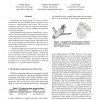Free Online Productivity Tools
i2Speak
i2Symbol
i2OCR
iTex2Img
iWeb2Print
iWeb2Shot
i2Type
iPdf2Split
iPdf2Merge
i2Bopomofo
i2Arabic
i2Style
i2Image
i2PDF
iLatex2Rtf
Sci2ools
106
click to vote
PG
2007
IEEE
2007
IEEE
Extending Catmull-Clark Subdivision and PCCM with Polar Structures
We complete and bring together two pairs of surface constructions that use polynomial pieces of degree (3,3) to associate a smooth surface with a mesh. The two pairs complement each other in that one extends the subdivisionmodeling paradigm, the other the NURBS patch approach to free-form modeling. Both Catmull-Clark [3] and polar subdivision [7] generalize bi-cubic spline subdivision. Together, they form a powerful combination for smooth object design: while CatmullClark subdivision is more suitable where few facets join, polar subdivision nicely models regions where many facets join, as when capping extruded features. We show how to easily combine the meshes of these two generalizations of bi-cubic spline subdivision. A related but different generalization of bi-cubic splines is to model non-tensor-product configurations by a finite set of smoothly connected bi-cubic patches. PCCM [12] does so for layouts where Catmull-Clark would apply. We show that a single NURBS patch can be us...
| Added | 04 Jun 2010 |
| Updated | 04 Jun 2010 |
| Type | Conference |
| Year | 2007 |
| Where | PG |
| Authors | Ashish Myles, Kestutis Karciauskas, Jörg Peters |
Comments (0)

